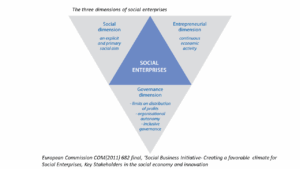By Ernest Ofori ASAMOAH (PROF)
The British Council, in its research on social enterprises on Sub-Saharan Africa (SSA), defines a social enterprise as a business that blends entrepreneurial activity with a social purpose.
Rather than prioritizing profit for owners or shareholders, its primary goal is to create a meaningful social impact.
Similarly, the European Commission (EC) describes social enterprises as key players in the social economy, aiming to generate social, societal, or environmental benefits rather than maximizing profits for investors or owners. The EC categorizes social enterprises into three main types:
- Businesses driven by a social or societal mission, often through social innovation.
- Businesses that reinvest most of their profits to further their social objectives.
- Businesses whose organizational structure or ownership model aligns with their mission, adhering to democratic, participatory principles or focusing on social justice.
The definition incorporates the three key dimensions of a social enterprise:
- Entrepreneurial dimension: Unlike traditional non-profits or social economy entities (which may pursue a social mission and generate some self-financing but do not necessarily engage in regular trading) social enterprises operate as active businesses with continuous economic activity.
- Social dimension: social enterprises have a primary and explicit social purpose, which distinguishes them from mainstream (for‑profit) enterprises;
- Governance dimension: social enterprises have mechanisms to ‘lock in’ the social goals of the organization, which distinguish them even more sharply from mainstream enterprises and traditional non-profit organizations/social economy entities.

In Europe, there are approximately 2 million social enterprises, primarily micro, small, and medium-sized enterprises (SMEs), accounting for 10percent of all businesses in the EU.
These enterprises employ more than 11 million people (about 6percent of the EU’s workforce) and up to 160 million Europeans are members of social economy enterprises.
Unlike traditional businesses, social enterprises do not distribute dividends to shareholders. Instead, they reinvest profits or surpluses to benefit the community or expand their mission.
In Canada, there is no single, unified definition of a social enterprise, resulting in a broad spectrum of business models. Social enterprises do not follow a specific corporate structure; they may take the form of non-profit organizations or registered charities operating revenue-generating businesses. Additionally, they can be for-profit businesses with a clear social goal.
Conclusion
Edition One of Doing Good and Making Money explores the concept of social enterprises, highlighting their unique blend of entrepreneurial activity and social purpose.
It defines social enterprises through three key dimensions: entrepreneurial, social, and governance, distinguishing them from both traditional non-profits and for-profit businesses.
The edition also examines the landscape of social enterprises across different regions. In Europe, social enterprises make up 10percent of all businesses, employing over 11 million people and reinvesting profits for community benefit.
Meanwhile, in Canada, the absence of a unified definition has led to a diverse range of social enterprise models, including non-profits, registered charities, and for-profit businesses with a social mission.
By outlining these key aspects, the edition sets the stage for understanding how social enterprises contribute to both economic sustainability and social impact.
>>>the writer is with Regent University College of Science and Technology. He can be reached via [email protected]










